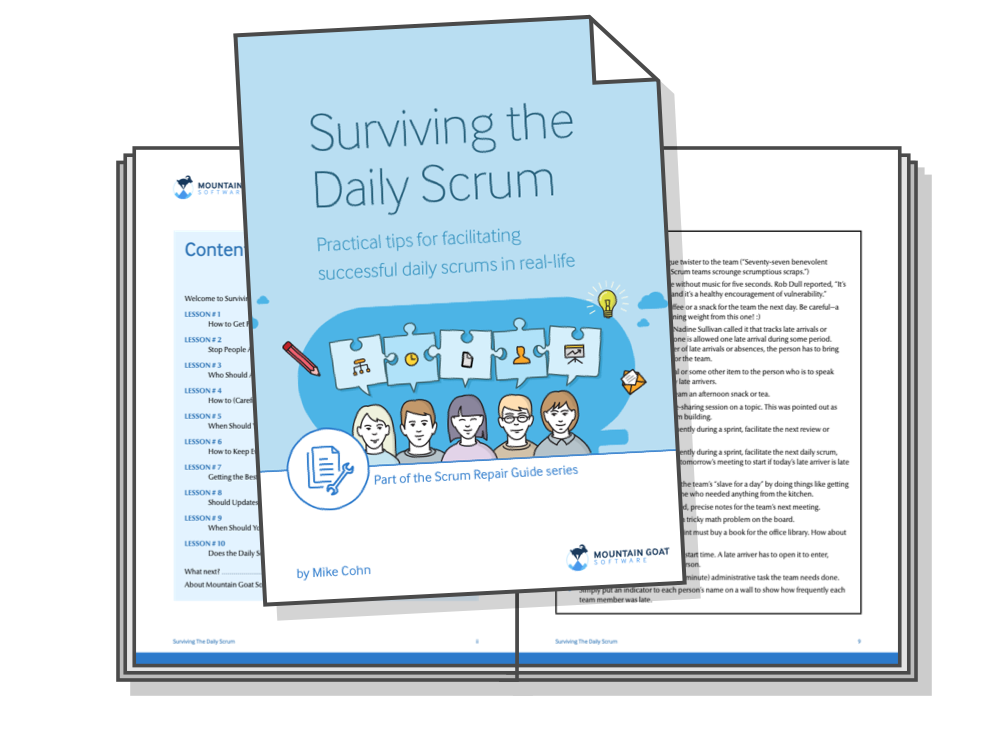The 6th principle of the Agile Manifesto reads,
“The most efficient and effective method of conveying information to and within a development team is face-to-face conversation.”
Now raise your hand if your team is physically in the same space for each and every daily scrum meeting you conduct. I would bet the number of you who can make that claim is very small. Even before the COVID pandemic disrupted the normal course of business, teams were already struggling with members who were geographically dispersed. The pandemic simply made this problem much more ubiquitous.
Since our geographic dispersion is now a fact of life, it’s a good idea for us to find ways to satisfy this Agile Manifesto principle (and others) in a remote-first world. I would go a step further: I suggest that there might just be some advantages to remote work that we wouldn’t have otherwise discovered. So let’s take full advantage of our own situation.
Take, for example, the daily scrum. It’s the only meeting in the Scrum framework that repeats in the course of a single sprint. If we are to thrive in a remote-first world, it’s important that we maximize the team’s time in this daily event.
Here are 7 tips for facilitating highly effective daily scrums remotely.
- Find a time that works for everyone
This has been a given for teams in the past but becomes crucial when your teams are geographically dispersed. Take into consideration the time zones of your team members and find an overlapping time that works for everyone without causing too much pain for any one group.
If you do have members spread across vastly different time zones, see if you can “share the pain,” meaning that each group gives a little so that one group doesn’t have to give a lot. If one location can stay a little late while the other arrives a little early, everyone sacrifices equally so that no one part of your team feels like second-class citizens.
Remember, it’s just 15 minutes. This meeting requires collaboration time, so finding some small overlap can greatly enhance the team’s ability to communicate. - Leave extra time for personal talk
In a virtualized world, we can all feel more isolated and cut off from the other human beings we work with on a daily basis. People naturally trust each other more and work better together when we see co-workers as fellow humans. So I suggest breaking the daily scrum timebox, and giving your daily scrum an extra 5 minutes that you will use at the top of the meeting.
Tell everyone to show up 5 minutes before the daily scrum so that you can maintain typical water cooler conversations while virtual. Talk about anything: a show you just watched last night, sports scores, your pets, or something going on in your family. A bit of nonprofessional connection helps prevent employees from feeling isolated while working from home. - Turn cameras on
If we can’t be in the same physical space, we can at least see each other. So much of communication is non-verbal; we miss out on a lot when we don’t see one another’s real faces.
I suggest using something like Zoom’s speaker view function, where the person speaking is bigger and everyone can see them easily. This makes the person who is speaking the center of attention at that moment. It will help limit side conversations and one hopes it will revert any attention that could be misguidedly placed on the Scrum Master back to the developers instead. - Make team data visible
As I mentioned earlier, a remote daily scrum has its advantages. You can easily share whatever visualizations would be most helpful to the team while the meeting is occurring. For example, share a picture of your team’s sprint burndown chart as team members enter the meeting. The Scrum Master doesn’t need to call attention to it, only display it.
The team can see their progress toward their sprint goal while coming into the event. Many teams also find advantages in displaying their sprint backlog throughout the meeting. The discussion can then focus on the items in progress rather than moving person by person. - Get creative with how you communicate
The context of a remote meeting is very different from in-person ones. But you can develop a simple system to overcome the disadvantages of a remote environment. For example, many teams find it useful to visually communicate with cards when issues arise. Someone speaking while on mute? People can hold up their “You’re Muted” cards. Bandwidth issues? How about a “You’re frozen” card?
For more of a Scrum-specific example, if someone is rambling on and on in a daily scrum, you might choose to hold up an Elmo card. E.L.M.O stands for “Enough, let’s move on.” You can have fun creating your own cards or simply buy a set (like this one: https://www.collaborationsuperpowers.com/shop/). Free apps (https://videocuecards.com/) let you display a card on your phone. - Make use of online tools to enhance the meeting
Remember that much of the technology we use daily didn’t exist back in 2001 when the Agile Manifesto was written. Keep in mind the purpose of the daily scrum: to make a plan for the day’s work. Then be creative about how you fulfill this purpose.
I’m always in favor of spoken conversation but I have encountered teams that use something like Slack instead so the daily scrum can be held asynchronously. While using the tool started as a substitute to a traditional daily scrum, some teams I know now prefer it to what they did before. Other tools such as Range or Standuply incorporate combinations of synchronous and asynchronous devices to keep teams connected.
Communication and collaboration are the goal. The content’s more important than the context, so let developers decide how they prefer to collaborate. - Take advantage of being inside each other’s homes
I mentioned leaving time before or even after a meeting for water cooler-type discussions. Take advantage as well of the fact that people are joining from their homes in order to get to know each other more personally.
Have everyone introduce their pets, kids, and significant others to the group. Do a quick show-and-tell before each standup so team members can share something they care about from their home. Encouraging people to reveal themselves a little will go a long way to create a sense of psychological safety and trust on the team.
Above everything, remember that we are people who believe in inspecting and adapting. The way you conducted a daily scrum in person likely won’t work remotely. Instead of attempting to simply convert what you did in person to a remote version, find what works best given the new paradigm we find ourselves in now.
What are some of the ways you have adapted your daily scrum if you are now working mostly with remote teams? Any tips you’ve learned and want to share? I’d love to hear them in the comments below.









